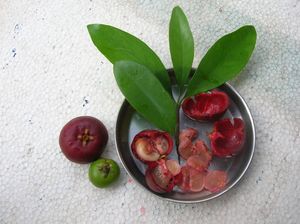Note: This is a project under development. The articles on this wiki are just being initiated and broadly incomplete. You can Help creating new pages.
Difference between revisions of "Garcinia indica - Vrikshamia"
Chaithrika (talk | contribs) m (Chaithrika moved page Kokum to Vrikshamia,: renaming as per convention) |
Chaithrika (talk | contribs) (+some improvements) |
||
| Line 39: | Line 39: | ||
</references> | </references> | ||
| + | ==External link== | ||
| + | |||
| + | * [http://www.flowersofindia.net/catalog/slides/Kokam.html flowerofindia] | ||
[[Category:Herbs]] | [[Category:Herbs]] | ||
Revision as of 10:54, 4 March 2017
Garcinia indica [1] , a plant in the mangosteen family (Clusiaceae), commonly known as kokum, is a fruit-bearing tree that has culinary, pharmaceutical, and industrial uses.
The genus Garcinia, belonging to the family Clusiaceae, includes about 200 species found in the Old World tropics, mostly in Asia and Africa. Garcinia indica is indigenous to the Western Ghats region of India located along the western coast of the country. Of the 35 species found in India, 17 are endemic. Of these, seven are endemic to the Western Ghats, six in the Andaman and Nicobar Islands and four in the northeastern region of India.
Garcinia indica is found in forest lands, riversides and wastelands. These plants prefer evergreen forests, but sometimes they also thrive in areas with relatively low rainfall. It is also cultivated on a small scale. It does not require irrigation, spraying of pesticides or fertilizers.
Contents
USES
- The fresh fruit is preserved with sugar to make a bright-red squash that is bottled for sale. The syrup is diluted with water to make a refreshing drink).
- The outer cover of fruit is dried in the sun to get aamsul or kokam. It is also known as bhirand in Konkani and punarpuli/muragalu in Kannada. It is used as a staple souring agent typically in Goan cuisine and some parts of Maharashtra and Karnataka. Kokum yields a peculiar flavour and blackish red colour. As a souring agent, it is used as an alternative to tamarind in curries and other dishes from the Goa and Konkan region.[citation needed] It is also used in cuisine from Gujarat, where it is frequently used to add flavor and tartness to dal (lentil soup) for flavor balance, and parts of South India.It is extensively used in Assamese cuisine in many dishes like " masor tenga " or sour fish curry and " tenga dali " or sour dal. It is also used as a cure for upset stomach and colds. A few dry pieces are soaked in water for some time and then the pieces are mashed in the water itself and can be taken in whole.
- Kokum squash or kokum concentrate is used in preparing a drink (sherbet) which is bright red in colour.
- Further, the extract/ concentrate of this fruit is called aagal in Konkani and Marathi. It is added during the preparation of solkadhi, along with coconut milk.
- The seed of Garcinia indica contains 23–26% oil, which remains solid at room temperature. It is used in the preparation of confectionery, medicines and cosmetics.
- Recently, industries have started extracting hydroxycitric acid (HCA) from the rind of the fruit.
- The tree is ornamental, with a dense canopy of green leaves and red-tinged, tender, young leaves. The oily extract called kokum tel is used in foot massage, and to treat burns.
Common name
- English - Kokam
- Kannada - ಪುನರ್ಪುಳಿ; ಮುರ್ಗಿನ
- Hindi - कोकम
